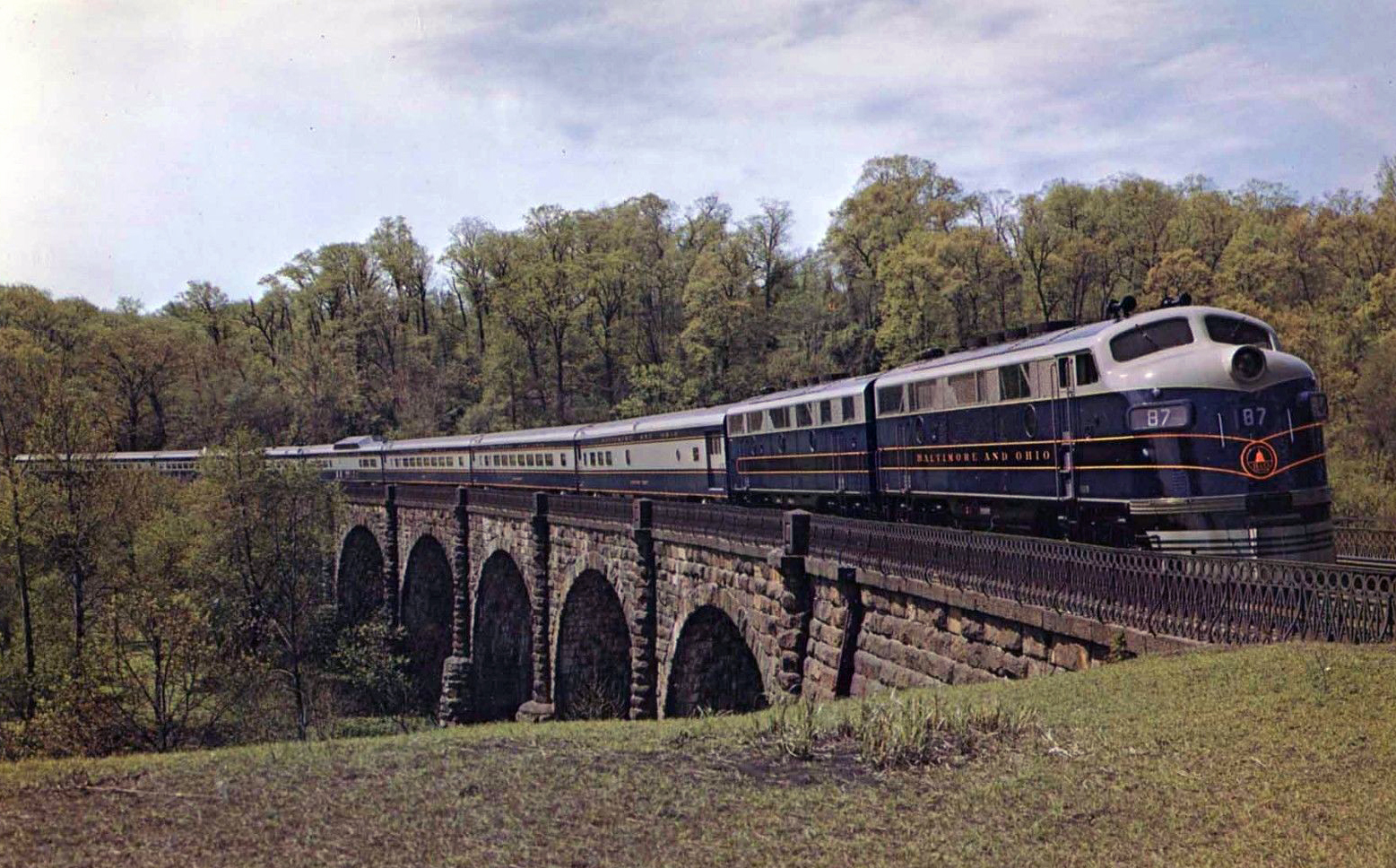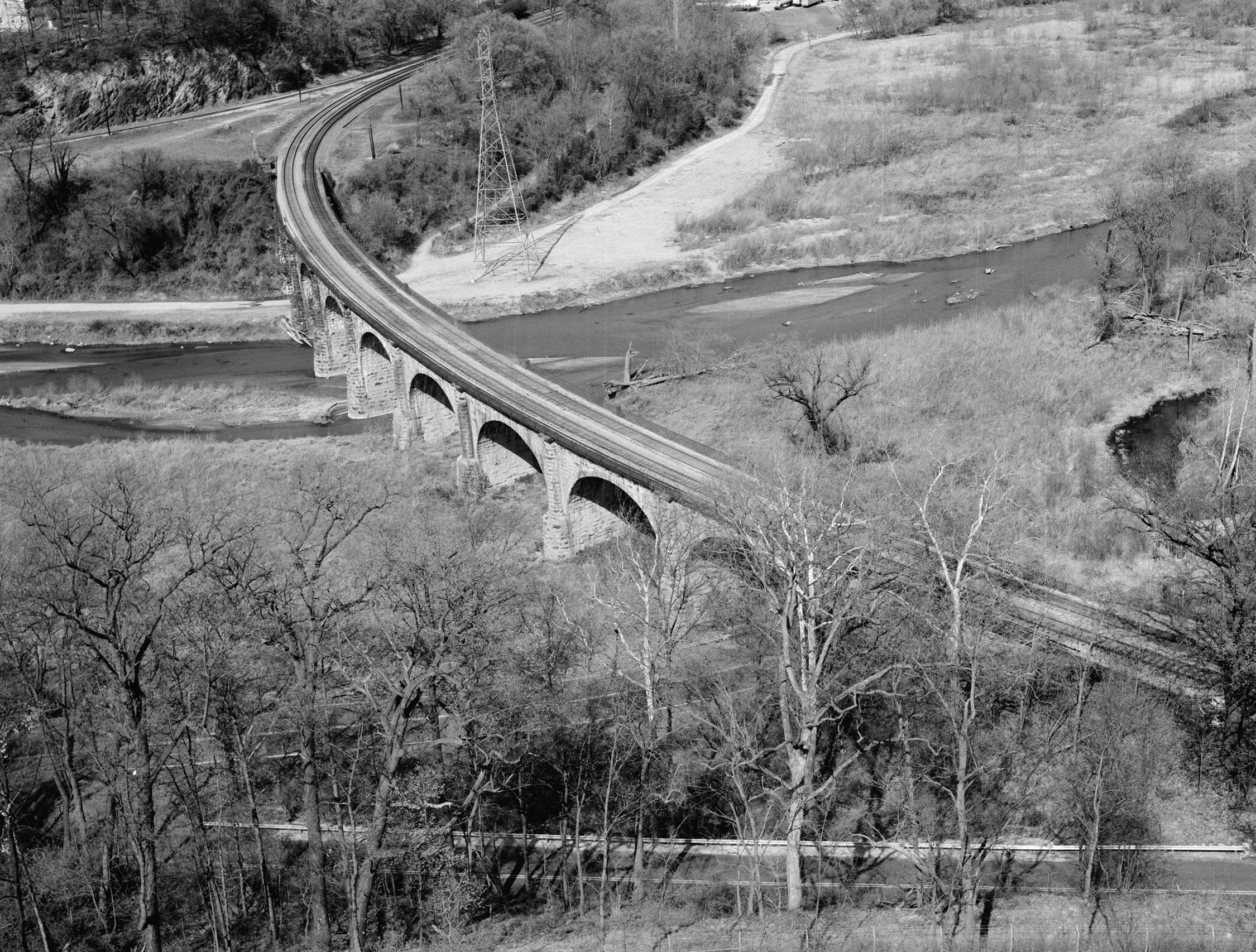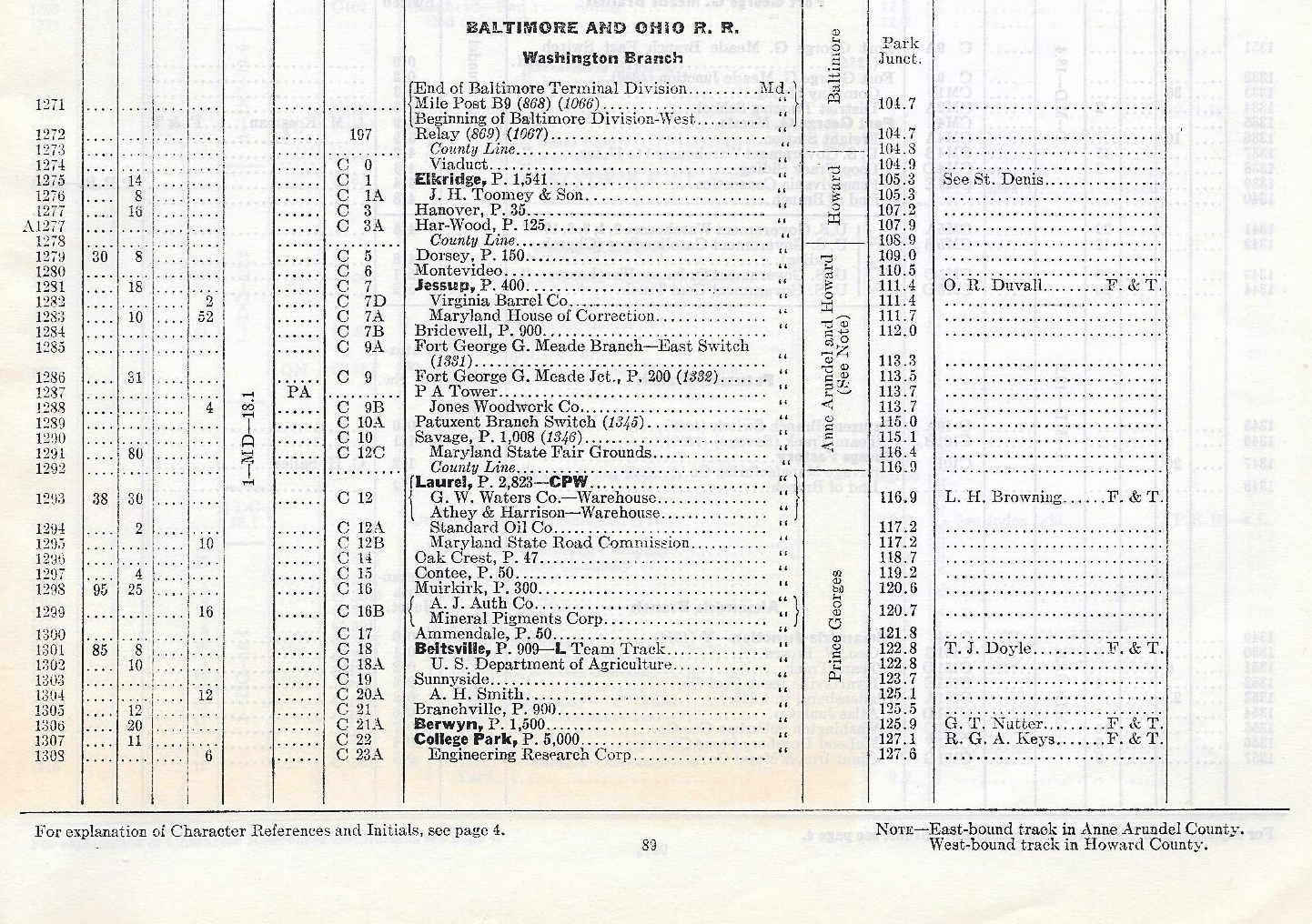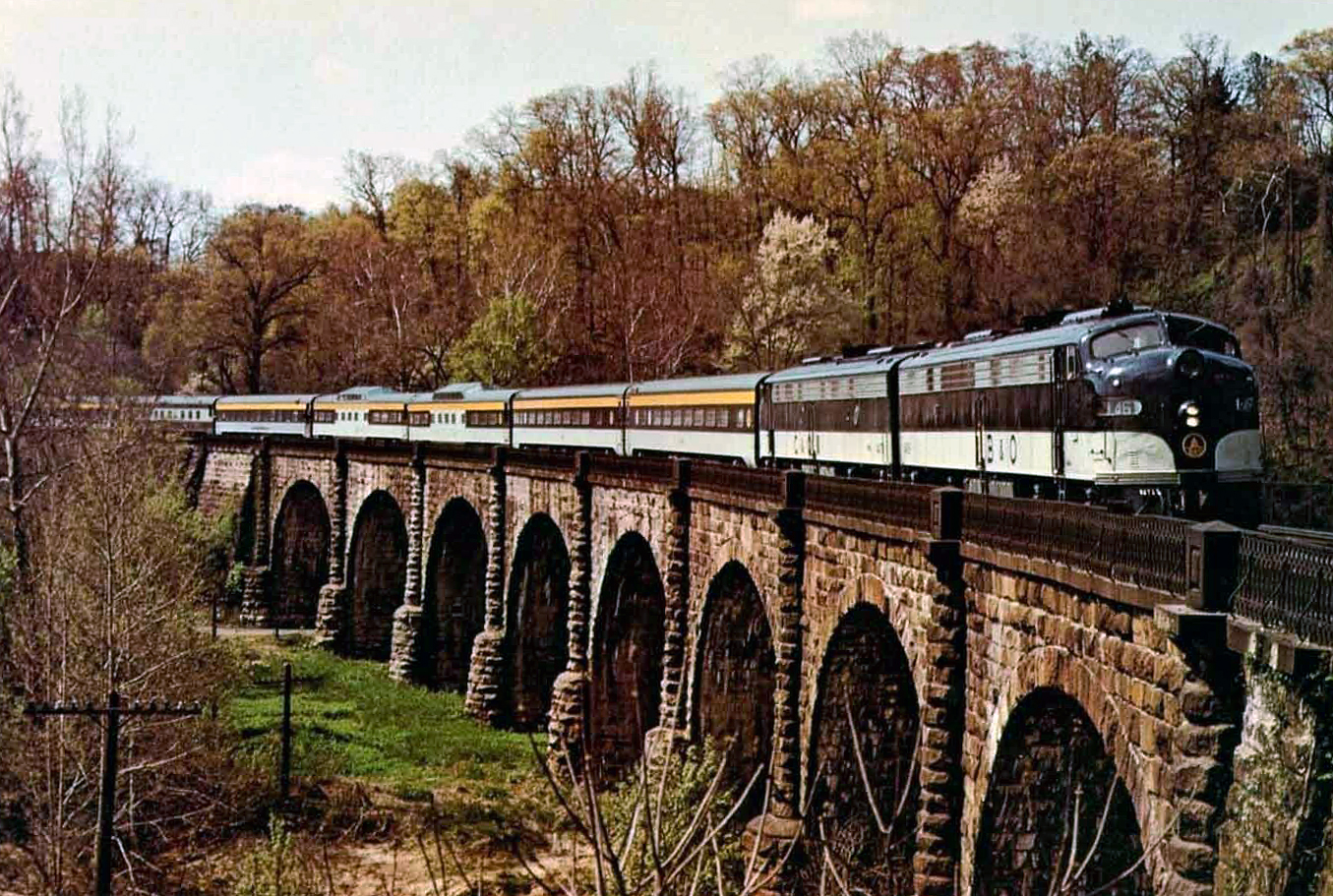B&O's Thomas Viaduct (Bridge): History and Photos
Last revised: March 1, 2025
By: Adam Burns
Thomas Viaduct was part of the B&O's realignment of its main line in the mid-1830s to a more southerly heading that would eventually connect to Washington, D.C., officially known as the Washington Branch (it technically did not become part of the railroad's through main line until the late 1860s).
Despite being completed in 1835, the Thomas Viaduct is still in operational condition today—a testament to the visionaries behind its inception and the strength of the materials used in its formation.
Such was the agricultural and commercial significance of the Thomas Viaduct that it was fiercely protected during the Civil War. The Union forces recognized its strategic importance, thus heavily guarding it from potential attacks by Confederate sympathizers.
The viaduct is the oldest multi-span masonry arch bridge of its kind and one of the oldest railroad bridges that is still in use today, carrying countless CSX Transportation freight and MARC commuter trains daily. Today, the viaduct has received the rare honor as a National Historic Landmark.
Publicly, Thomas Viaduct became one of the most famous location along the fabled B&O. The railroad regularly used it for marketing purposes, such as in the photo below.
In one particularly noteworthy setting, the "Royal Blue" was posed alongside Britain's "Coronation Scot," led by 4-6-2 #6229, the "Duchess of Hamilton." This locomotive was owned by the London Midland & Scottish Railway and still survives today.
While the B&O always kept the bridge maintained to very high standards, including its wrought-iron railing, this attention to detail faded as the years passed.
 In this Baltimore & Ohio company photo the newly reequipped "Columbian," powered by an A-B- set of F3's (note the new Strata-Dome mid-train), poses on historic Thomas Viaduct (Maryland) spanning the Patapsco River during the spring of 1949.
In this Baltimore & Ohio company photo the newly reequipped "Columbian," powered by an A-B- set of F3's (note the new Strata-Dome mid-train), poses on historic Thomas Viaduct (Maryland) spanning the Patapsco River during the spring of 1949.Baltimore & Ohio
After the being was acquired by the Chesapeake & Ohio and then joined the Chessie System consortium in 1972, company policy shifted away from maintaining property to such high standards.
Unfortunately, this was not isolated to the B&O; the industry, in general, lost interest. There were several factors involved, from declining revenues to the discontinuance of passenger trains.
Today, CSX has been criticized several times for its maintenance of this National Historic Landmark; trees and shrubs grow from crevices in the stone and the railing is in desperate need of repair and overhaul. The viaduct was the first major project on the Baltimore & Ohio's recently planned Washington Branch to connect the nation's capital.
The line diverged at Relay, Maryland and less than a mile away was the Patapsco River and Patapsco Valley, both of which need to be crossed. At the time construction commenced on the bridge on July, 4 1833 the Baltimore & Ohio had yet to reach Harpers Ferry, Virginia.
History
The B&O sought a sturdy and lasting structure to transport locomotives and carriages safely across the Patapsco River Valley. The viaduct served as an essential component of the railway network—facilitating consistency in the smooth flow of goods and passengers.
However, the railroad was in money trouble during the bridge's construction. It had virtually used up all of its funding to date and had yet to not only reach Cumberland, Maryland but also to establish any viable means of traffic.
Benjamin Henry Latrobe
To construct this notable structure, locally quarried granite was predominantly used. The durable material's presence greatly contributed to the viaduct's longevity and resilience throughout the years. The bridge requirements dictated an estimated 24,476 tons (22,195 metric tons) of this granite to be utilized during its construction.
The viaduct was designed by Benjamin Henry Latrobe, Jr. with actual construction carried out by contractor John McCartney (McCartney was ultimately awarded the job to build the the viaduct since he had successfully built the nearby Patterson Viaduct a few years earlier).
The major issue in building the bridge was the curve required, which had never been attempted before in American history. To accomplish the task the seven piers carried a wedge shape to compensate for the 4 degrees of curvature needed.
 An aerial view of Thomas Viaduct, looking towards the northeast, as it appeared in April, 1971. Note that the Baltimore & Ohio's main line, bound for points east and west, can be seen in the background. Jack Boucher photo.
An aerial view of Thomas Viaduct, looking towards the northeast, as it appeared in April, 1971. Note that the Baltimore & Ohio's main line, bound for points east and west, can be seen in the background. Jack Boucher photo.Construction
When construction of the bridge was finished, officially on July 4, 1835, it rose to a height of 59 feet (18 meters) above the Patapsco River and was 612 feet in length (187 meters).
Furthermore, it spans a width of approximately 26.5 feet (8 meters), making for a notable sight nestled in the landscape. At the time it was the longest stone-arch masonry bridge.
It featured eight arches, which were 59-feet in length and was wide enough (roughly 26-feet) to accommodate two tracks, which it still carries today. The bridge received its name, Thomas Viaduct, after the B&O's first president, Phillip Thomas.
During its initial years, skeptics doubted the viaduct's durability, predicting that it would collapse under the heavy weight of the locomotives. The structure's first crossing by a train—a locomotive chaperoned by Latrobe himself—put these doubts to rest, demonstrating the viaduct's resilience and strength.
Publicity Photos
Over the years, and especially during the streamliner age, the B&O regularly used the structure to stage publicity photos of its latest trains or notable locomotives such as the fabled Royal Blue (Washington/Baltimore - New York), Capitol Limited (New York - Chicago), and the first streamlined diesel locomotive for regular, main line service, Electro-Motive's stylish "EA."
Location
 From the Baltimore & Ohio's 1948 "Official List" you can see the location of what was named only as "Viaduct" on the Washington Branch. Author's collection.
From the Baltimore & Ohio's 1948 "Official List" you can see the location of what was named only as "Viaduct" on the Washington Branch. Author's collection. The Baltimore & Ohio was always very cognizant of its storied history. Here, the final "Capitol Limited" is posed on Thomas Viaduct on May 1, 1971. James Jeffrey photo.
The Baltimore & Ohio was always very cognizant of its storied history. Here, the final "Capitol Limited" is posed on Thomas Viaduct on May 1, 1971. James Jeffrey photo.Today
To honor the completion of the bridge, the contractor John McCartney, had a 15-foot obelisk built with the names of the builder, chief engineer, superintendent, board of directors and designer inscribed on the monument. The original obelisk has since been destroyed but a replacement now stands in its place.
In the summer of 2010 the viaduct celebrated its 175th anniversary and in conjunction with the milestone it has become known that two preservationists, John Slater and Jim Dilts, are spearheading an effort to create the Thomas Viaduct Park to help maintain the bridge and make visitors aware of the structure's historic and engineering noteworthiness.
Legacy
Today, the Thomas Viaduct is considered a historic civil engineering landmark by the American Society of Civil Engineers. A testament to its enduring significance and innovative construction techniques.
Throughout the years, the viaduct has undergone minor modifications to accommodate the evolving railroad technology. Yet, it largely remains in its original state, bearing witness to the engineering prowess of its builders.
Its construction was a significant event of its time, employing a large number of people over a period of two years. The workers, mainly Irish immigrants, were subject to harsh conditions yet persevered to successfully build the marvel we see today.
The viaduct was notable for its economic impact. The speed and efficiency it offered revolutionized transportation, setting the stage for industrial growth in the city of Baltimore and beyond.
The Thomas Viaduct serves as an icon of the early days of American railroad transportation. Its endurance throughout the years is testament to its design, construction methodologies, and the materials used. It stands as a physical reminder of USA's industrial age.
Today, the Thomas Viaduct continues to be a popular tourist spot. Visitors flock to see this historic structure, hiking the trails, picnicking in the parkland that surrounds it, or just admiring the strength and beauty of the granite structure.
In 1964, the Thomas Viaduct was designated a National Historic Landmark. It can also be found on the National Register of Historic Places since 1966—an honor that validates its historic significance.
The Thomas Viaduct has seen the evolution of locomotives—from the early days of steam engines to today's high-speed electric trains—demonstrating its adaptability and resilience.
Despite its historical significance, care must be taken to maintain and preserve the Thomas Viaduct. Various rehabilitation projects have taken place, ensuring the structure's continued service and its protected status.
The Thomas Viaduct is an outstanding example of early 19th-century innovation in civil engineering. The use of stone as a material for construction, at a time when wood was predominantly used, shows the groundbreaking nature of this structure.
In conclusion, the Thomas Viaduct with its aesthetic appeal, historic significance, and enduring functionality stands as an admirable testament to successful early engineering.
Its influence can be seen in the many stone viaducts that followed its design. Today, as it continues its role in modern railroad transportation, it is undoubtedly a pertinent landmark in the annals of American civil engineering and transportation history.
Contents
Recent Articles
-
Rio Grande 2-8-2 Locomotives (K-37): Specs, Roster, Photos
Apr 15, 25 12:57 PM
Rio Grande's Class K-37 Mikes were itsdge steamers to enter service in the late 1920s. Today, all but two survive. -
Rio Grande 2-8-2 Locomotives (K-36): Specs, Roster, Photos
Apr 15, 25 11:09 AM
The Rio Grande's K-36 2-8-2s were its last new Mikados purchased for narrow-gauge use. Today, all but one survives. -
Rio Grande 2-8-2 Locomotives (Class K-28): Specs, Roster, Photos
Apr 14, 25 10:24 PM
Rio Grande's Class K-28 Mikados were its newest narrow-gauge steam locomotives since the Mudhens of the early 1900s. Today, three survive.


